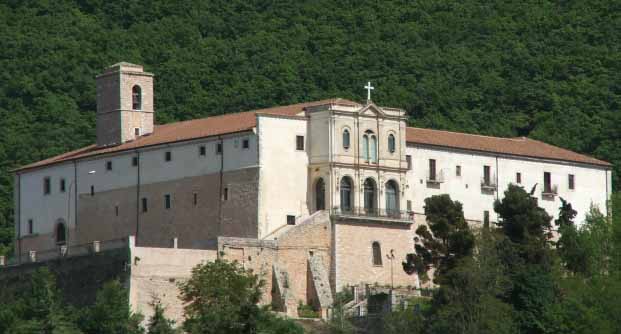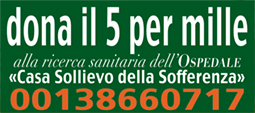The sanctuary of the St. Matthew the Apostle
THE SANCTUARY OF ST. MATTHEW THE APOSTLE
The sanctuary of St. Matthew is very popular both with pilgrims and with tourists. It is located along the Via Sacra dei Longobardi, less than thirty kilometres from Monte Sant’Angelo, it is twenty-eight kilometres from Manfredonia and only five kilometres from San Giovanni Rotondo. It is surrounded by a beautiful green place, where there are many species of trees (oak trees, beech trees, ash trees, maple trees, chestnut trees and holm oak trees). It is a place rich in history, art, culture and above all it is full of faith and spirituality. As regards the story, in its century-old life, you can distinguish three major periods: the Benedictine period, the Cistercian period and finally the Franciscan period. The first period lasted 6-7 centuries: from 600-700 to 1311. The Cistercian period lasted about three centuries: from 1311 to 1578. The Franciscan period began in 1578 and it is still continuing, for more than four centuries with various circumstances. Until the end of the sixteenth century it was known as St. John in Lamis. Benedictines dedicated it to St. John the Baptist. At the end of the sixteenth century, thanks to the arrival of a relic of the great Apostle and Evangelist the cult in honour of St. Matthew began. At first sight, the Sanctuary does not seem a convent, but a medieval castle in the shape of a massive and powerful quadrilateral. Pilgrims and tourists can freely visit the church, the sacristy, the choir, the chapel of confessions and the artistic crib. In the church, jealously guarded in a glass niche, behind the main altar, there is the relic of Saint Matthew. The wooden statue of St. Matthew with a Byzantine style is the XII- XIII century; it is the remake of a Christ made by a friar, in the late sixteenth century, who handed him the pen with which the Evangelist wrote the Gospel. It is completely realised of Gargano olive wood and on the book there is this date: 1596. On the walls you can see remains of medieval frescos (XI-XII century), among which there is the representation of St. Francis during his visit in Gargano and the remains of St. John the Baptist. Laterally, there are some altars in baroque style made with stone from Monte Sant’Angelo dedicated to St. Joseph, the Immaculate Conception, St. Anthony of Padua and St. John the Baptist from which you have the church's canonical name. Above these altars, there are recent paintings made by an artist of San Marco, Filippo Pirro, depicting a group of Franciscans of the Capitanata, including San Francesco Antonio Fasani. In the apse, a massive wooden choir is placed that some unknown Friars Minor of the convent carved in 1600. On lunettes, you can admire fourteen beautiful pictures dating back to 1927 depicting the Way of the Cross and made of papier-mâché and clay by artist Salvatore Bruno of Lecce.
The remains of frescos that can be seen on the walls, date back to the XI-XII century; while the sculpture depicting the Passion of Christ in history is placed on the balcony of the church and it is realised by the artist N. Petruccelli.
On request, you can visit: -“the large refectory”, very simple, where you can admire a magnificent seventeenth-century fresco depicting the Last Supper and some paintings depicting Franciscan saints. -“The small refectory” made from the combination of arches and vaults in rough stone and it is the result of medieval architecture. You can go to the “room of the fire” where there was a big fireplace and monks would gather in front of it to pray. -“ the auditorium” and the room of sacred art and of the ex-votos. -the cloister - the loggia with the wall of the old Benedictine-Cistercian church. In 1926, on the east side, a balcony was built next to the only nave to the outside of the church. In 1838, the central facade was equipped with the current staircase in order to access the entrance which leads to the cloister of rectangular shape, through a series of arches and sails, and that reminds us of the Benedictine spirit showing the origins of the building. From the cloister you can admire the loggia of the sixteenth century and the medieval well on which there is the statue of the Archangel Michael.
You can also visit the library by appointment; it is one of the most well-stocked in the region. It is dedicated to “Father Antonio Fania of Rignano Garganico”, with more than 60.000 volumes, it is among the most important of the Capitanata, thanks to the presence of a considerable number of works of art within it (paintings, statues, idols, and a collection of ancient Bibles and numerous maps depicting the Capitanata). Special attention is devoted to the lapidarium, to the archaeological collection, to the gallery of the Cistercians and to the statue of St. Mary the Crowned, restored to its original splendour. An authentic work of art is the crib that all the worshippers and tourists should not miss to admire. Tourists and pilgrims who wish to take part in the Holy Mass, have four Masses in the morning, from 9:00 to 12:00 (one every hour); and two in the afternoon: at 17:00 and at 18:00 (from 1 November until 31 March) or at 18:00 and 19:00 (from 1 April until 31 October). Those who like to take part in the Holy Mass with Gregorian chants, performed by the Choir of the Sanctuary, can participate in the festive Holy Mass at 11:00.
THE “FRACCHIE”
A few kilometres from the Sanctuary, in San Marco in Lamis, every year and every Good Friday for the commemoration of the Passion of Christ, there is an influx of foreigners in occasion of the traditional Procession of the “fracchie”, a spectacular popular religious event, which has been repeated regularly for about three centuries.
The “fracchie” are huge torches, made of large tree trunks, opened longitudinally in the shape of a cone and filled with firewood, in order to be lit at dusk, so they will become campfires which will light the path of Our Lady of Sorrows in the streets of the town in the search of Jesus, her dead son.








